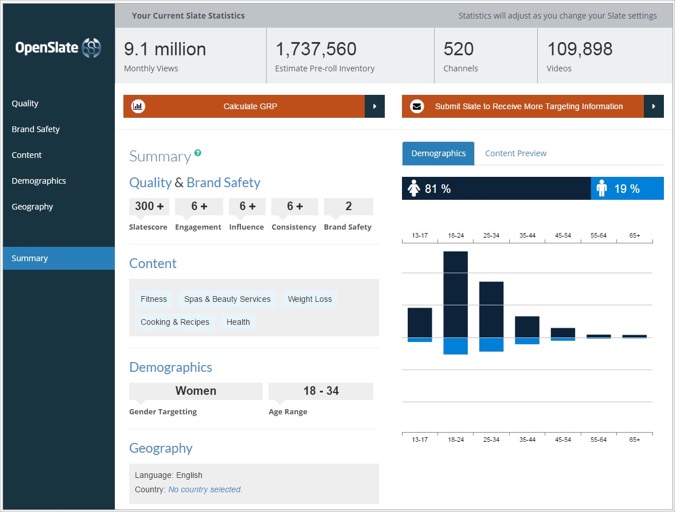-
OpenSlate’s New GRP Planning Tool Translates YouTube Audiences to TV Metrics
The convergence of video and TV advertising is everywhere these days. The latest evidence is a new tool that OpenSlate unveiled last week that gives ad buyers the ability to screen YouTube inventory based on custom criteria and then see how it translates into TV-equivalent reach and demographics.
OpenSlate’s CEO Mike Henry demo’d the new YouTube GRP Planning Tool for me last week, illustrating how buyers can enter target audience information to build an “unwired TV network,” then enter a budget and see how this equates to Total Rating Points and GRPs for a YouTube campaign.OpenSlate’s bread and butter business has been scoring YouTube’s myriad content channels for content quality, brand safety and subject matter. The scoring is based on data provided by the YouTube channels and via partnerships with MCNs. The new tool builds on the scoring data to help TV buyers better understand how their spending would translate in TV terms.

Mike explained that in order to build the new GRP tool, OpenSlate spent the last year tagging test campaigns on YouTube with Nielsen pixels in order to verify that target audiences aligned with Nielsen’s profiles.
As of last week, the tool is publicly available so ad buyers can use it to model potential YouTube spending. The goal is to provide transparency and scale with they type of demographic measurement buyers are used to.
Buyers can take the data and activate campaigns themselves, or OpenSlate will do it through an internal campaign team, at no charge. Mike emphasized that OpenSlate positions itself strictly as a data provider, and does not want to be seen as arbitraging media.
YouTube remains a wild and wooly environment for ad buyers who are attracted to its scale and engagement, but are anxious about how to act on it. By connecting its scoring data with its new GRP tool, OpenSlate is helping pave the way for more cross-platform campaigns and shifting of TV dollars.Categories: Advertising, Data


